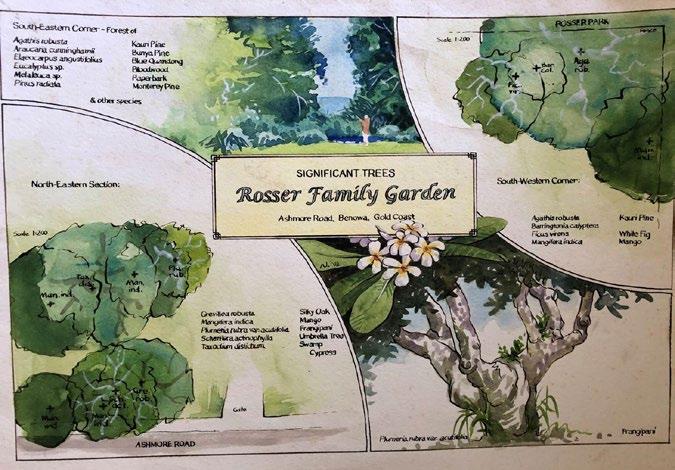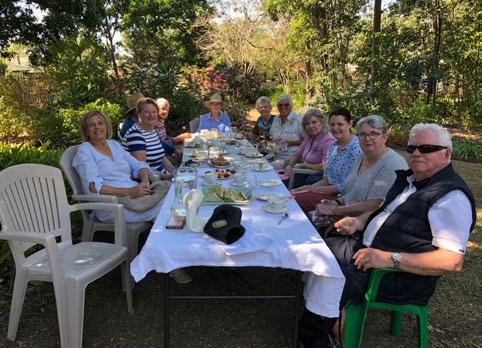
8 minute read
One of Australia’s newer botanic gardens has a heritage gem at its heart
from THE BOTANIC GARDENer
by BGANZ
It is 50 years since some of the land where the Gold Coast Regional Botanic Gardens is located was gifted to the City of Gold Coast in 1969 by John and Essie Rosser. The home, built in 1922, the home block and associated garden remained with the family until several years ago. Kate reflects on its history and efforts to restore the Rosser garden.
Kate Heffernan, The Rosser Garden
Advertisement
Most people associate the Gold Coast with its tourism image and are unaware that the city has a significant history dating back to the cedar getters of the mid-19th century. The Gold Coast Regional Botanic Gardens (Rosser Park) is located at Benowa, four kilometres from Surfers Paradise.
Benowa’s history began with cotton farming along the alluvial floodplains of Nerang River, on land directly opposite the botanic gardens. Cotton proved unsuccessful, and was followed by sugar cane farming introduced by Scottish-born Robert Muir in 1866 on a 455 hectare allotment. It included the 36 hectare site of the botanic gardens.
Muir, the sugarcane and associated mill have an interesting history of their own, but immediately post World War One sugar cane became unviable and the land was subdivided into 23 allotments as the Parberry Estate. Small holdings included dairy farms, maize and corn, and vegetable production. Some of these allotments are now part of the botanic gardens.
John and Essie Rosser purchased Lot 19A, approximately three hectares on the well grassed ridge, scattered with several remnant eucalypts, as well as trees planted around the original Muir home during the late 1860s and 1870s. Muir’s house was no longer standing.
Several trees planted by Muir remain, and together with other mature trees in the Rosser Garden and Orchard, were initially assessed by Diploma of Horticulture students from Gold Coast TAFE. The students interviewed John and Essie’s daughter Gene Rosser in 2000.
It was a surprise for students, and for me in my teaching role, to discover Kauri Pine Agathis robusta, Frangipani Plumeria acutifolia, Bunya Pine Araucaria bidwillii, Swamp Cypress Taxodium distichum, Hoop Pine Araucaria cunninghamiana and two massive mango trees Mangifera indica, all of which were then around one hundred and forty years old.
Significant trees in Rosser Family Garden. Watercolour by Nick Walford-Smith
The Rosser’s built a home on the land and made extensions through the 1930s and 40s. Together with the garden, the house was listed on the Gold Coast Local Heritage Register (GCLHR). The associated citations were based on the properties importance in demonstrating the evolution or pattern of Gold Coast’s history. Extracts from the comments include:
• ‘….the gardens include examples of significant mature trees’ Remnant eucalypts on lagoon Photo: Kate Heffernan


Kauri Pine planted by Robert Muir c. 1860s Photo: Kate Heffernan
• ‘Both the house and garden were designed to take advantage of the views over the floodplain and the hinterland. Today, the house with its secluded and picturesque mature garden setting and with its important view-lines, has aesthetic significance.’
• ‘The place has a special association with John and Essie Rosser who made a notable contribution to the Gold Coast city through their generous donation of a significant parcel of land for environmental purposes.’
John and Essie Rosser donated 2.7 hectares of their land, retaining a small portion surrounding the house where they remained living. Their desire was to ensure the land retained its rural character, and not be developed. In 1987 John was interviewed by the Gold Coast Bulletin one year prior to his death at 95. He observed ‘We’re country people...none of us want to see our land lose its identity.’
curtilage of the original donation. John was an apiarist with bee hives in various hinterland locations. He produced honey on the home allotment, selling it locally and in bulk to Brisbane markets. The family were largely self-supporting with dairy cows and large vegetable gardens. John established an orchard after constructing terraces along the slope. It was planted with various fruit trees, including Mango and Macadamia. These terraces remain and are within the
Essie was the gardener and as a keen photographer kept a record of garden and family. These photographs and their daughter Gene Rosser’s memories have assisted two detailed investigations into the Rosser period garden history.
The overall garden is divided into five distinct periods:
• Muir’s from late 1860s to 1920
• John and Essie Rosser’s from 1924 to1988
• Gene Rosser’s from 1988 to 2010
• City of Gold Coast and Gene Rosser 2010 to present.

John Rosser planting a tree. Photo courtesy of Gene Rosser
In 2010, I completed a detailed inventory and pictorial file of features, including garden items, trees, shrubs, perennials, ferns, bromeliads and orchids. The Rosser Garden Report was completed in March 2011. It influenced the GCLHR listing.
The report also led to the commencement of garden a restoration following the previous purchase of the remaining house and land from Gene by City of Gold Coast Council in 2009.
Widening of Ashmore Road in 1994 had resulted in a new entrance on the busy arterial road. Council subsequently planted a dense hedge of Red Powder Puff Calliandra haematocephala and Indian Hawthorn Raphiolepis indica as a screen. Both eventually became an impenetrable and uncontrollable thicket covered with Madeira Vine Andredera cordifolia, a weed of national significance and Cats Claw creeper Dolichandra unguis-cati, restricted under the Biodiversity Act 1994. These were the first removals during the restoration and renovation that commenced in 2011.
The earlier entrance led to the front door of the house. A long straight lawn axis remains evident today, although entry is now from busy Ashmore Road. It is hoped that eventually visitors to the garden can again enter along or close to the original grass path. A timber arch at the gate displayed a crimson Bougainvillea, now reaching high into adjoining trees. All that remains of the arch is a timber post.
Essie grew up on a farm. She propagated and planted cuttings shared by others, as well as collecting seeds from both annuals and perennials. Plants were also supplied from her sister, a keen traveller and plant enthusiast, and one brother, a keen gardener who exhibited successfully at local shows.

Front entrance and garden path 1933 showing Essie Rosser with the children. Photo courtesy of Gene Rosser

John’s background was English, and he spent time overseas during World War One. He read widely on many topics, and his library remains in the house. Gene describes him as a thoughtful man who determined the best site for the house by standing on piles of boxes to achieve the ideal aspect. The result is a house where every room has a view to the garden, and several windows looked out to the alluvial flood plains and hinterland beyond. Essie Rosser on the garden path in 1970. Photo courtesy of Gene Rosser

Other garden beds retain their curved form and once bordered by shrubs, perennials and flowering annuals they are now shaded by trees in many areas. Planting themes consistent with the period have replaced some earlier plantings which were extensive. The 2011 Garden Report listed 53 species of trees, 85 shrubs and bulbs, and a further 140 vines, palms, ferns, bromeliads and annuals. This included species from Gene’s garden activities from the 1980s which are primarily located in only a couple of the 18 garden beds. Annuals and flowering shrubs along garden path 1976. Photo: Essie Rosser
Most of Essie’s plants are either species or old hybrids and replacing some has been challenging. For instance, due to their deterioration it was impossible to identify the cultivars of some Camelia Camellia japonica, necessitating a search through old Camellia catalogues for cultivars predating the 1930s. Replacements had to be sourced from Victoria, and now staff and volunteers continue to seek out replacements for a number of other plant species no longer common in Queensland.
Visits have been limited to special groups such as Australian Institute of Horticulture and Australian Garden History Society. Although work is ongoing, finally in September it was both safe enough and visually ready for a trial guided visit by a small group of Friends. A Conservation Management Plan prepared in 2016 by Landscape Architect Catherine Broewer recommended small groups of up to 12 guests to avoid possible damage. The report also investigated and prioritised work for each garden bed.
The visit commenced with a presentation at the Friends Centre, discussing the context of the Rosser Garden in Queensland’s garden history followed by an hour-long walk and morning tea under the Swamp Cypress and Mango.
The Rosser House and Garden is a substantial asset for the City of Gold Coast. In terms of its relationship with the botanic gardens it is especially important, for its trees and its garden, and its links to the Rosser family and the early history of Benowa. It is fitting that the land donated by John and Essie forms part of the botanic gardens, providing due recognition of their commitment to the environment.
Authors Note: I have extended my earlier research of the Rosser Garden into the period of Robert Muir and his association with Michael and William Guilfoyle. I look forward to sharing these details later this year in a book on Gold Coast Regional Botanic Gardens.
Images extracted from Rosser House garden report Kate Heffernan 2011 reproduced from photographs courtesy Gene Rosser. Division of garden into management zones; Rosser’s House Conservation Management Plan 2016, Catherine Brouwer Landscape Architects.


Morning tea following presentation and walk. Gene Rosser at head of table. Photo: Rana Baguley










